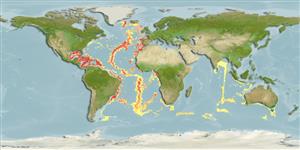Teleostei (teleosts) >
Aulopiformes (Grinners) >
Ipnopidae (Deep-sea tripod fishes) > Ipnopinae
Etymology: Ipnops: Greek, hypnos = sleep + Greek, ops = appearance (Ref. 45335).
More on author: Günther.
Environment: milieu / climate zone / depth range / distribution range
Ecology
Marine; bathydemersal; depth range 1789 - 3477 m (Ref. 26165). Deep-water
Eastern Indian Ocean: Australia. Western Atlantic: Mid Atlantic Bight and Bahamas. Eastern Atlantic: northwest Africa. Also known in Pacific Oceans (Ref. 26165).
Size / Weight / Age
Maturity: Lm ? range ? - ? cm
Max length : 13.2 cm SL male/unsexed; (Ref. 26165)
Short description
Identification keys | Morphology | Morphometrics
Inhabits the continental slope (Ref. 7300). Maximum depth from Ref. 58018.
Life cycle and mating behavior
Maturities | Reproduction | Spawnings | Egg(s) | Fecundities | Larvae
Paxton, J.R., D.F. Hoese, G.R. Allen and J.E. Hanley, 1989. Pisces. Petromyzontidae to Carangidae. Zoological Catalogue of Australia, Vol. 7. Australian Government Publishing Service, Canberra, 665 p. (Ref. 7300)
IUCN Red List Status (Ref. 130435)
Threat to humans
Harmless
Human uses
Tools
Special reports
Download XML
Internet sources
Estimates based on models
Preferred temperature (Ref.
123201): 2.9 - 4.5, mean 3.4 °C (based on 587 cells).
Phylogenetic diversity index (Ref.
82804): PD
50 = 0.6250 [Uniqueness, from 0.5 = low to 2.0 = high].
Bayesian length-weight: a=0.00102 (0.00046 - 0.00225), b=3.06 (2.88 - 3.24), in cm total length, based on all LWR estimates for this body shape (Ref.
93245).
Trophic level (Ref.
69278): 3.1 ±0.32 se; based on food items.
Resilience (Ref.
120179): Medium, minimum population doubling time 1.4 - 4.4 years (Preliminary K or Fecundity.).
Fishing Vulnerability (Ref.
59153): Low vulnerability (10 of 100).
